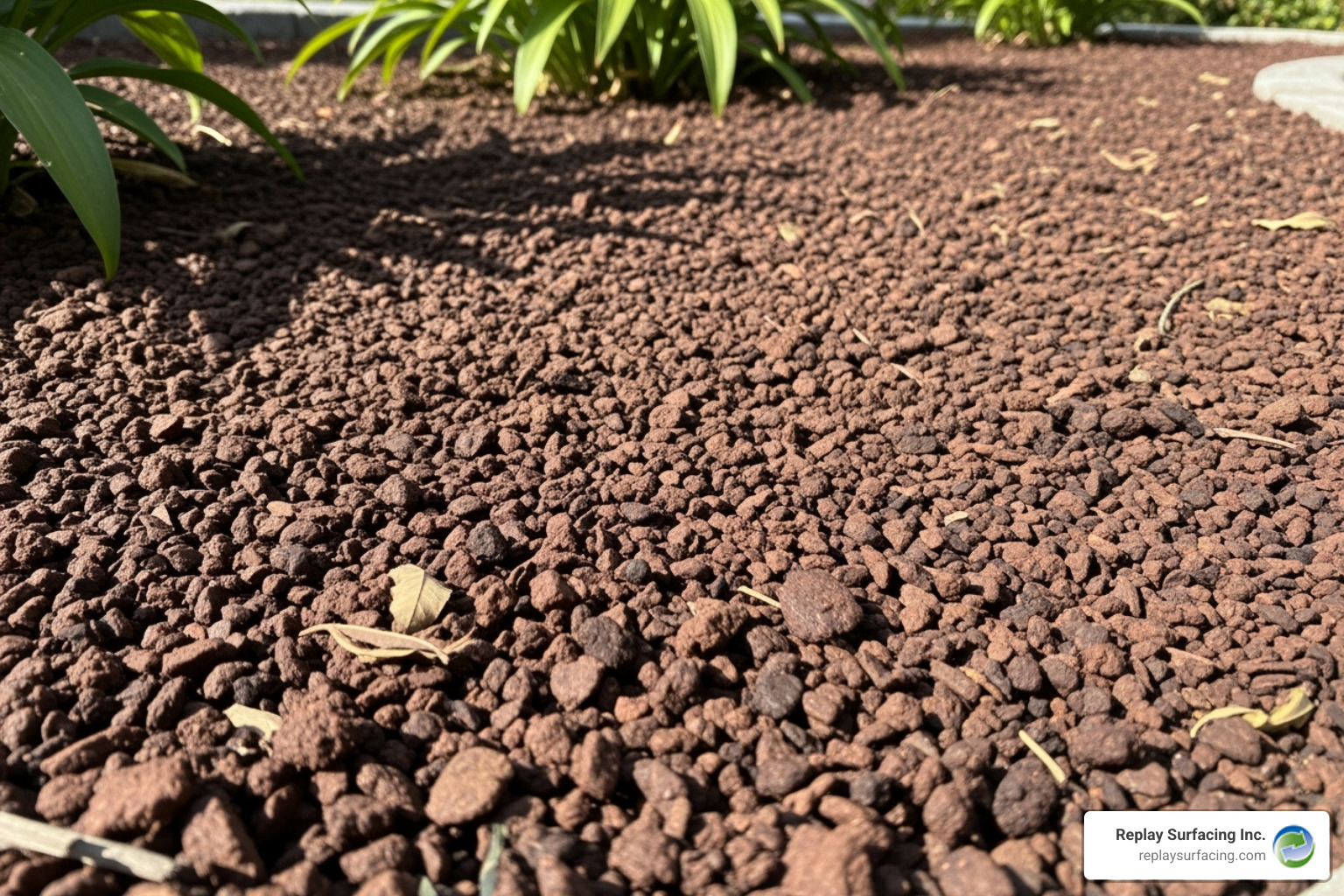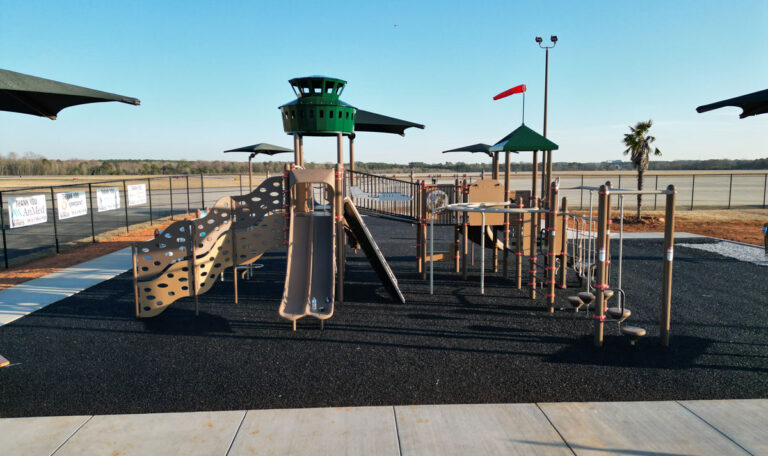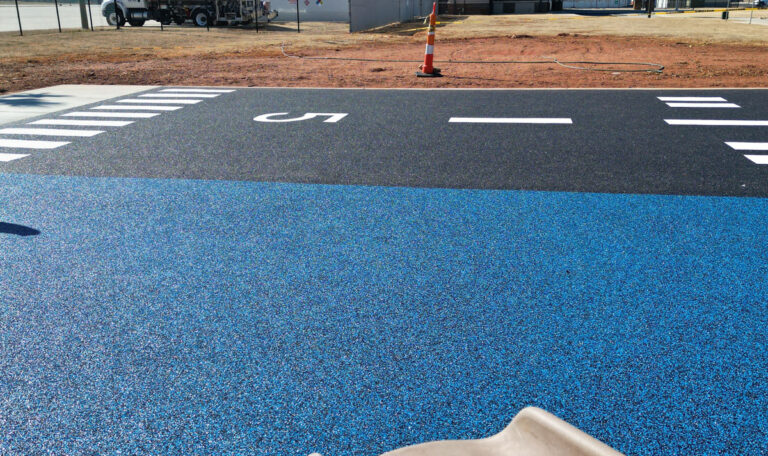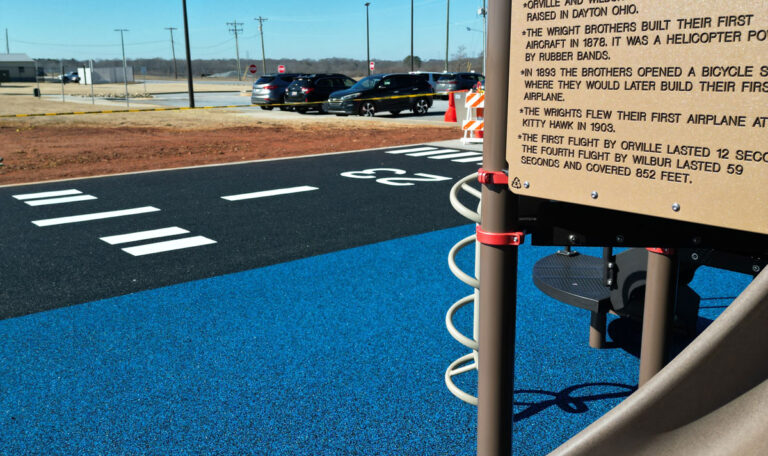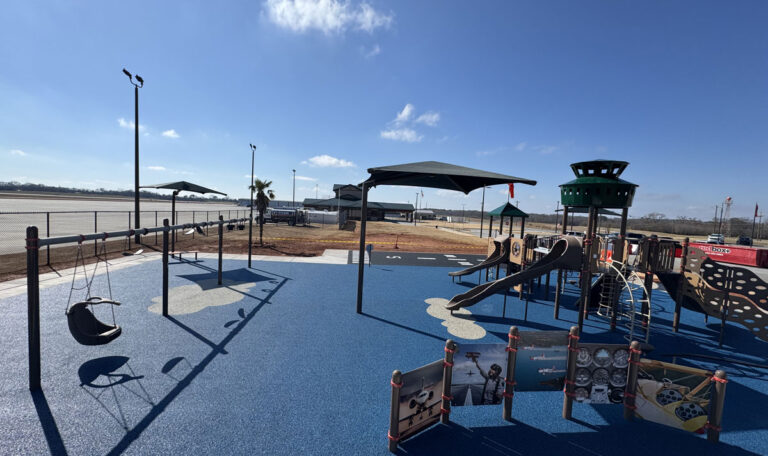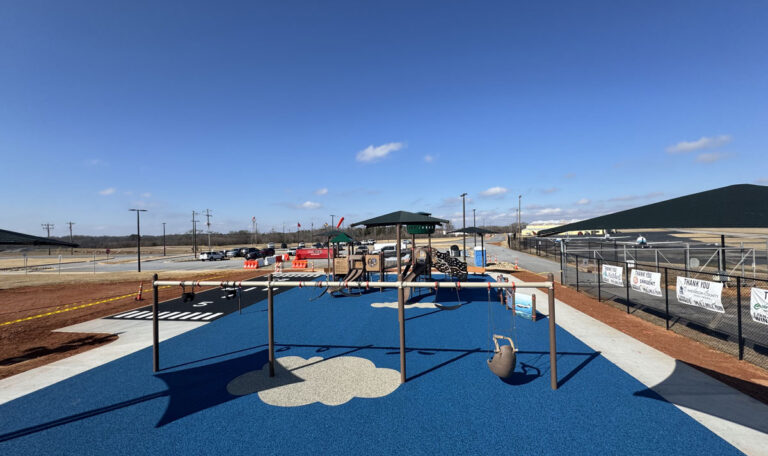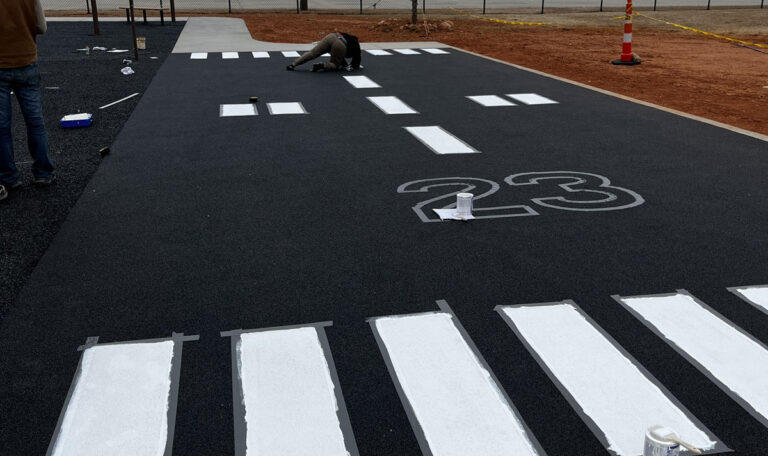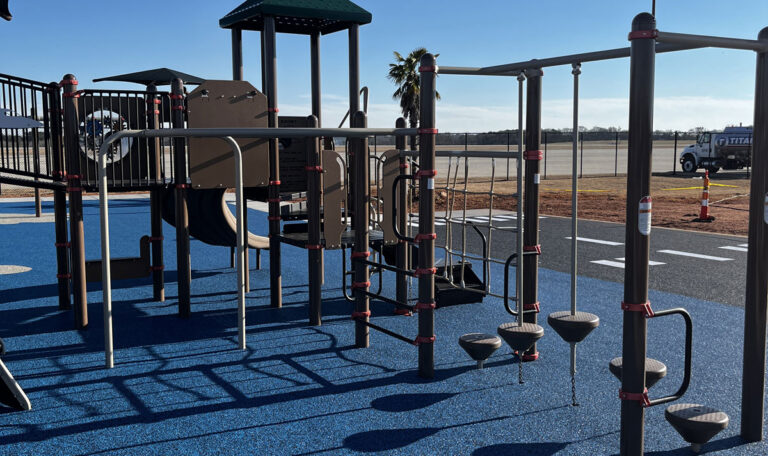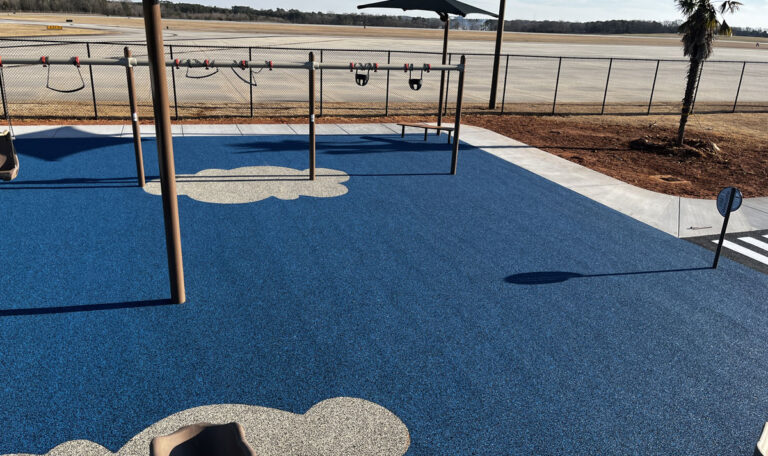Rubber Ground Cover in Charlotte NC: Your Complete Guide
Rubber ground cover is a versatile surfacing material made from recycled tires that offers a durable, low-maintenance alternative to traditional mulches and ground coverings. Here’s what you need to know:
Key Types:
- Rubber mulch – Shredded tire pieces for landscaping
- Bound rubber mulch – Bonded pieces for unified surfaces
- Rubber mats – Interlocking tiles for pathways and play areas
Primary Benefits:
- Lasts 10-20 years without replacement
- Superior fall protection for playgrounds
- Excellent drainage and weed suppression
- Available in multiple colors
- Made from 100% recycled materials
Main Considerations:
- Higher upfront cost than organic mulches
- Doesn’t enrich soil like wood chips
- Requires quality sourcing to avoid wire contamination
- May retain heat in sunny climates
Whether you’re managing a playground in Charlotte NC, designing landscapes in Nashville TN, or creating safe surfaces in Tucson AZ and Beaverton OR, understanding these basics helps you make an informed decision about rubber ground cover for your specific needs.
As someone who has spent years changing millions of pounds of scrap tires into sustainable rubber ground cover solutions at Replay Surfacing, I’ve seen how the right material choice can solve maintenance headaches while supporting environmental goals. My engineering background and hands-on experience in the surfacing industry have taught me that successful projects start with understanding both the benefits and limitations of each material option.
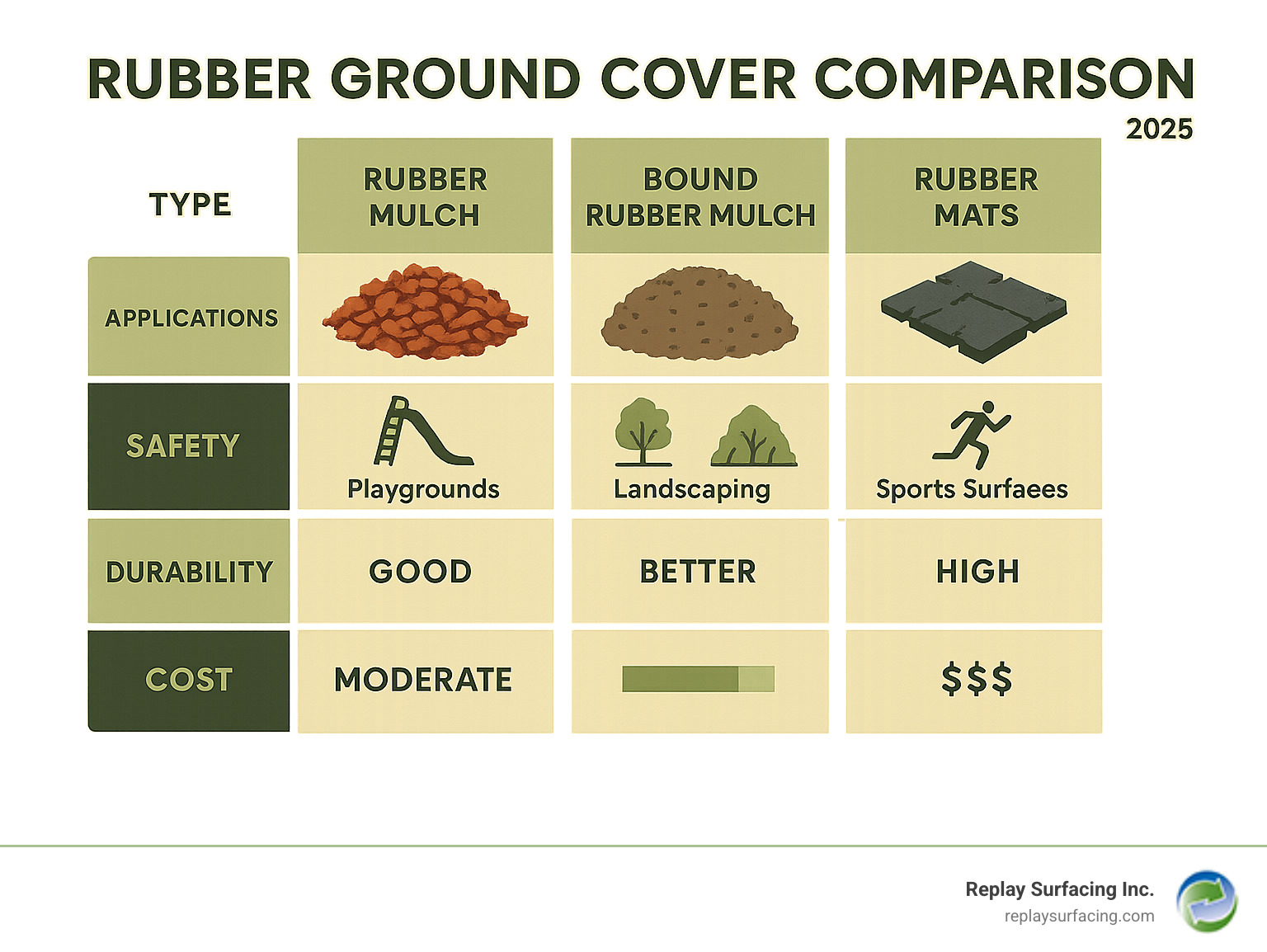
Handy rubber ground cover terms:
- installing rubber mulch
- is rubber mulch a safe surface for your child’s playground
- soft fall playground
What is Rubber Ground Cover? From Recycled Tire to Your Yard
Think about the millions of tires that wear out every year across America. Instead of letting them pile up in landfills, we’ve found a brilliant way to give them a second life as rubber ground cover. It’s basically recycled tire rubber that’s been transformed into a safe, colorful surface for playgrounds, gardens, and pathways.
The magic happens through a careful manufacturing process that starts with collecting scrap tires. The EPA reports that Americans discard around 290 million tires annually, so there’s no shortage of raw material. These tires go through a mechanical shredding process where the steel belts and fabric pieces are removed using magnetic separation and specialized sifting techniques.
Here’s where it gets interesting – once the rubber is shredded into small pieces, it gets coated with non-toxic, UV-stable coloring. This is what creates those vibrant reds, blues, and greens you see on playgrounds. The entire process transforms what was once an environmental problem into a valuable resource that can last decades.
What makes rubber ground cover different from traditional wood mulch is that it’s completely inorganic. It won’t decompose, attract insects, or need constant replacement. This change from waste tire to beautiful surface material is at the heart of what we do at Replay Surfacing, turning environmental challenges into practical solutions for communities in Charlotte NC, Columbia SC, Raleigh NC, and throughout our service areas including Connecticut, Indiana, Nashville TN, Beaverton OR, and Lake Charles Louisiana. Our commitment to Sustainable Construction Materials drives everything we create.
The Environmental Angle
Every time we install rubber ground cover, we’re solving two problems at once – creating a better surface and keeping tires out of landfills. It’s a win-win that makes us feel pretty good about what we do.
The environmental benefits are real and measurable. When we divert tires from landfills, we’re preventing them from taking up space for centuries (tires don’t break down naturally). Instead, we’re turning them into surfaces that protect children, beautify landscapes, and serve communities for 10-20 years.
The recycling benefits go beyond just waste reduction. Rubber ground cover doesn’t need the water that traditional mulches require for maintenance or decomposition. This water conservation aspect is especially valuable in areas like our service regions, where every drop counts. Whether it’s a playground in sunny Tucson AZ or a community center in Sanford NC, these surfaces help reduce ongoing resource consumption.
This sustainable approach makes rubber ground cover an excellent choice for environmentally conscious communities throughout Charlotte NC, Columbia SC, Raleigh NC, and our other service areas including Connecticut, Indiana, Nashville TN, Beaverton OR, and Lake Charles Louisiana. Our Recycled Rubber Mulch represents this commitment to turning waste into something wonderful.
Types and Colors Available
The variety in rubber ground cover might surprise you. We’re not talking about boring black chunks – there’s a whole rainbow of options designed to fit different needs and styles.
Rubber nuggets are the chunky option, looking similar to small stones or bark chips. They drain beautifully and give surfaces a distinctive texture that works great for pathways and garden borders. Shredded rubber mulch has that familiar fibrous look of traditional wood mulch but with all the benefits of recycled rubber. The pieces interlock slightly, which helps them stay put even on slopes.
Then there’s Bound Rubber Mulch, which is our premium option. We take shredded rubber pieces and bond them together with a polyurethane binder, creating a semi-permanent surface that looks clean and won’t migrate or scatter. It’s perfect for high-traffic areas where you want the benefits of rubber without loose pieces.
The color options are where things get really fun. Brown gives you that classic, natural look that blends seamlessly with existing landscapes. Black creates a sleek, modern appearance that makes other colors pop. Red is a playground favorite – it’s cheerful and energetic. Blue works beautifully around water features or when you want something unique. Green mimics natural grass and foliage, making it perfect for garden applications.
We even offer specialized color matching through our Custom Color Pool Decks service, showing just how flexible rubber surfacing can be for creative projects.
Weighing the Options: Pros, Cons, and Key Comparisons
Making the right choice for your rubber ground cover project means understanding both the incredible benefits and potential challenges that come with this innovative material. It’s not about finding a perfect solution—it’s about finding the right solution for your specific needs.
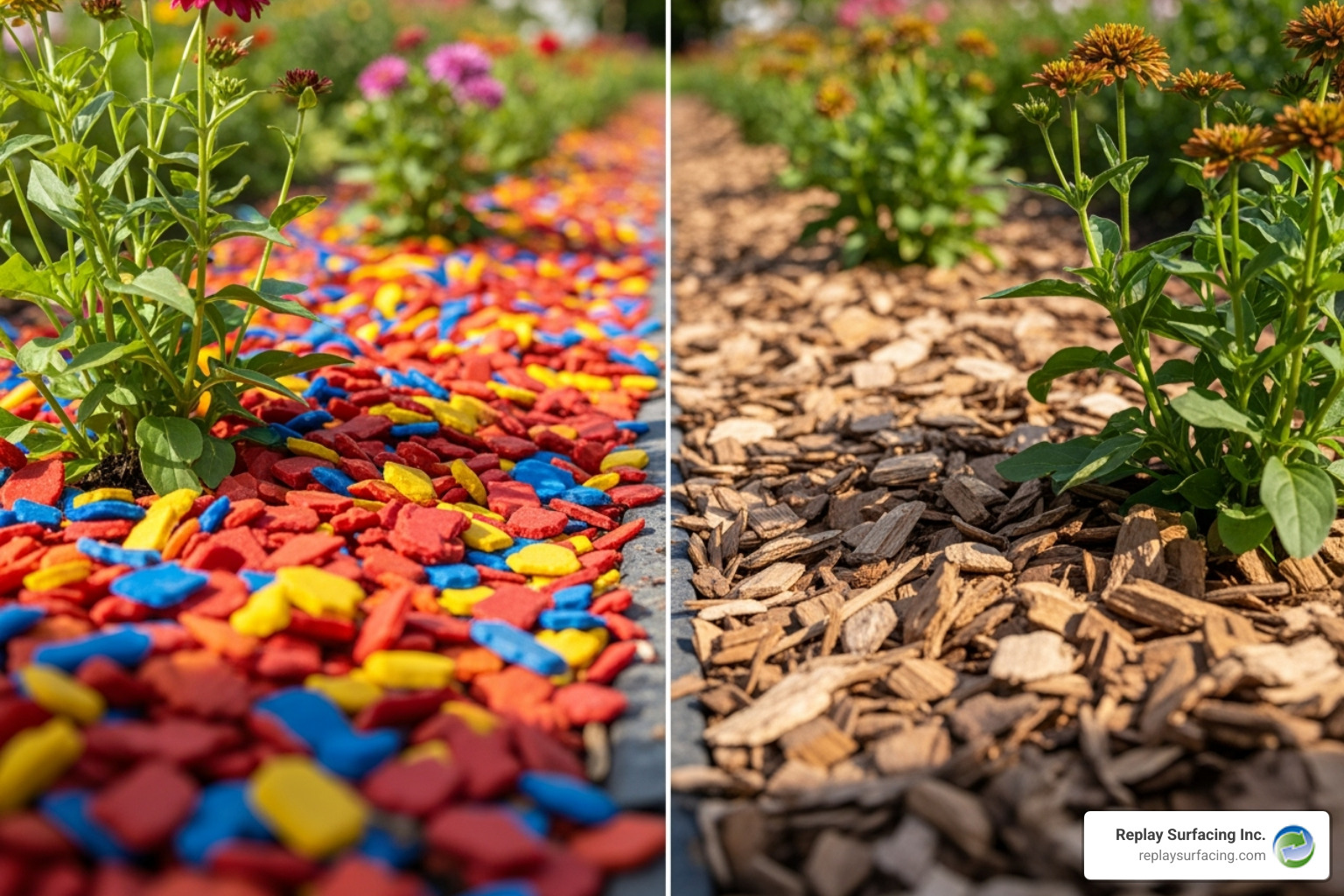
The Advantages of Rubber Mulch
When you choose rubber ground cover, you’re investing in a material that delivers impressive long-term value. The most striking benefit? Durability that lasts 10 to 20 years—imagine not having to replace your mulch every spring for the next two decades!
Low maintenance becomes a reality with rubber mulch. Unlike traditional organic options that decompose and need constant replenishment, rubber mulch stays put. It naturally suppresses weeds without chemicals and resists pests like termites that love to feast on wood-based alternatives. For busy property managers in Charlotte NC or Nashville TN, this translates to significantly reduced maintenance costs and headaches.
Safety takes center stage with superior fall protection. Rubber mulch absorbs impact better than any other playground surface material—it’s actually more than twice as effective as wood chips or sand at cushioning falls. This makes it the gold standard for playgrounds across Columbia SC and Raleigh NC, where child safety is paramount. Our Shock Absorbing Playground Surfaces demonstrate this protective advantage in action.
Excellent drainage means no more soggy, muddy play areas after rainstorms. The rubber doesn’t absorb water, so surfaces dry quickly and stay usable year-round. Plus, the color retention is remarkable—many manufacturers guarantee vibrant colors for up to 12 years, ensuring your investment looks fresh and appealing for years to come.
The insulation properties offer an unexpected bonus: rubber mulch keeps soil about 10 degrees cooler in summer and 10 degrees warmer in winter, creating more stable growing conditions for nearby plants.
For a comprehensive look at these benefits, explore our detailed guide on the Advantages of Playground Rubber Mulch: Safety, Maintenance, and Durability.
Potential Risks and Considerations
Being transparent about challenges helps you make the best decision for your project. Toxicity concerns represent the most debated aspect of rubber mulch. Since it’s made from recycled tires, some studies have raised concerns about potential chemical leaching from the materials used in tire manufacturing. While reputable manufacturers use processes to ensure safety and provide products that are certified as non-toxic for use in playgrounds and landscapes in areas like Tucson AZ and Lake Charles Louisiana, it’s a topic the scientific community continues to study for long-term effects.
Flammability risks deserve serious consideration. Despite some marketing claims, rubber mulch is not fireproof. Certain academic studies have found that, under specific conditions, shredded rubber can be more combustible than other mulch types. Once ignited, it can be difficult to extinguish and may produce toxic smoke. For this reason, it’s important to follow installation guidelines and keep rubber mulch away from potential ignition sources, a key consideration for projects in both residential and commercial spaces across Connecticut and Indiana.
In sunny climates like Tucson AZ, heat absorption becomes a practical concern. Rubber ground cover can become uncomfortably hot during peak summer temperatures, potentially making playground surfaces too warm for bare feet.
Unlike organic mulches, rubber provides no soil enrichment. It won’t break down to add nutrients or improve soil structure, which matters if you’re using it in garden beds with plants that benefit from organic matter.
The higher upfront cost compared to wood chips can be a budget consideration, though the long-term value often justifies the investment. For detailed information about potential health concerns, visit our page on Rubber Mulch Toxic.
Rubber Mulch vs. Traditional Mulches
Understanding how rubber ground cover compares to traditional options helps clarify when each makes sense. Safety clearly favors rubber mulch, especially for playgrounds—its superior impact absorption makes it the preferred choice for protecting children from fall injuries.
Cost presents an interesting trade-off. While rubber mulch costs more initially, traditional wood chips require annual replacement, making rubber more economical over time. A playground in Beaverton OR using rubber mulch might spend more upfront but save thousands in replacement costs over a decade.
Maintenance strongly favors rubber options. Traditional mulches need regular topping off, pest management, and complete replacement. Rubber mulch needs occasional raking and leaf removal—that’s it. For commercial properties in Sanford NC managing multiple locations, this difference is substantial.
Durability isn’t even close—rubber wins decisively with its 10-20 year lifespan versus annual replacement for organic options. Aesthetics become personal preference, though rubber’s color retention means it stays vibrant while wood mulch fades and grays.
Environmental impact creates complexity. While rubber diverts tires from landfills (a major plus), organic mulches provide soil benefits and eventually biodegrade naturally. The best choice depends on your specific environmental priorities and site conditions.
Our team at Replay Surfacing has installed successful projects using both approaches across our service areas in Charlotte NC, Columbia SC, Raleigh NC, Sanford NC, Tucson AZ, Connecticut, Indiana, Nashville TN, Beaverton OR, and Lake Charles Louisiana. The key is matching the material to your specific needs, budget, and long-term goals.

